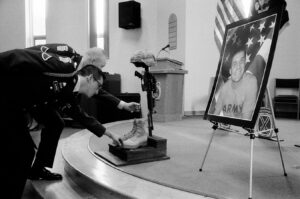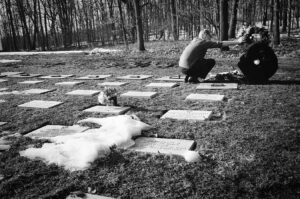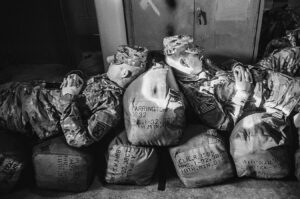In 2009 I began documenting U.S. military troops deployed to war in Afghanistan. I have continued to photograph the lives of same military service members for the past decade in Afghanistan and at Fort Drum’s U.S. military base in New York – documenting soldiers at war, as they make their way home from deployment, and then back to war again – in what for many military families has become an endless cycle.
The majority of Americans enlisting in the U.S. infantry are in the age range of 18 – 25 years old. They come from a variety of backgrounds, but most come from a low socioeconomic demographic and lack a high school degree, are exhausted from difficult situations at home, or some have a past drug addictions and criminal records. Many are eager to join the U.S. army in hopes of going to college on the GI Bill, while most simply want to escape where they are from to see the world, do something noble, or to start anew.
However, the US military’s return home from the wars in Iraq and Afghanistan has repercussions as devastating and traumatic as war itself. After the welcome home ceremonies are over, service members begin waging a different type of war – one of invisible wounds and inner-conflict which can go undetected for years. According to the U.S. Department of Veterans Affairs (V.A.) about three million U.S. service members have served in the wars in Iraq and Afghanistan for the past twenty-two years since 9/11. Among the veterans treated at the V.A. for psychological disorders, 1/3 have been diagnosed with Post Traumatic Stress Disorder (PTSD), while 1/4 have been diagnosed with Traumatic Brain Injury (TBI). Nearly 56% of Iraq and Afghanistan veterans have been diagnosed with at least one mental health condition. Symptoms of PTSD and TBI can include depression, anxiety, changes in personality, sleep disturbance, substance abuse, and violent behavior, while the most extreme cases result in suicide. In 2009, the rate of suicide among U.S. military service members surpassed the number of those killed in action in Iraq and Afghanistan combined. Today, one U.S. veteran commits suicide roughly every hour, totaling to about twenty-two a day.
Through visual journalism and storytelling, this project aims to create community support and awareness at a grassroots and media level. From 2011 – 2023 The Homecoming Project participated in over 50 exhibition platforms and educational programs worldwide, bringing awareness to the hundreds of thousands. Through this body of work, I hope to tell a story that illuminates the realities of war and its aftermath, the depth of exposure affecting those involved, and complexities of trauma and courage experienced by a generation of soldiers and their surrounding communities.











